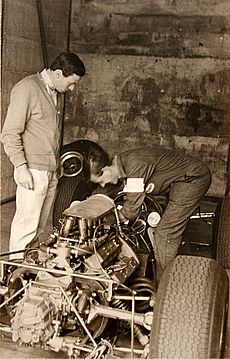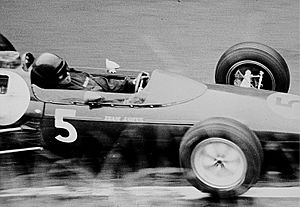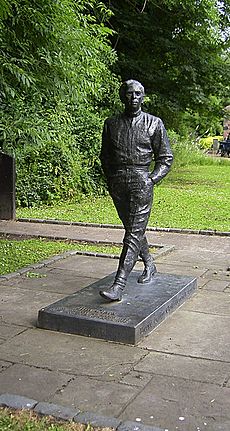Jim Clark facts for kids
Quick facts for kids Jim ClarkOBE |
|||||||
|---|---|---|---|---|---|---|---|

Clark in Zandvoort in 1965
|
|||||||
| Born | James Clark 4 March 1936 Kilmany, Fife, Scotland |
||||||
| Died | 7 April 1968 (aged 32) Hockenheim, Baden-Württemberg, West Germany |
||||||
| Championship titles | |||||||
| FIA World Drivers' Championship (1963, 1965) British Saloon Car Championship (1964) Tasman Series (1965, 1967, 1968) Major victories Indianapolis 500 (1965) |
|||||||
| Formula One World Championship career | |||||||
| Nationality | |||||||
| Active years | 1960–1968 | ||||||
| Teams | Lotus | ||||||
| Entries | 73 (72 starts) | ||||||
| Championships | 2 (1963, 1965) | ||||||
| Wins | 25 | ||||||
| Podiums | 32 | ||||||
| Career points | 255 (274) | ||||||
| Pole positions | 33 | ||||||
| Fastest laps | 28 | ||||||
| First entry | 1960 Dutch Grand Prix | ||||||
| First win | 1962 Belgian Grand Prix | ||||||
| Last win | 1968 South African Grand Prix | ||||||
| Last entry | 1968 South African Grand Prix | ||||||
| Champ Car career | |||||||
| 9 races run over 5 years | |||||||
| Best finish | 6th (1963) | ||||||
| First race | 1963 Indianapolis 500 (Indianapolis) | ||||||
| Last race | 1967 Rex Mays 300 (Riverside) | ||||||
| First win | 1963 Tony Bettenhausen 200 (Milwaukee) | ||||||
| Last win | 1965 Indianapolis 500 (Indianapolis) | ||||||
|
|||||||
| 24 Hours of Le Mans career | |||||||
| Years | 1959–1961 | ||||||
| Teams | Border Reivers | ||||||
| Best finish | 3rd (1960) | ||||||
| Class wins | 0 | ||||||
James "Jim" Clark was a famous British Formula One racing driver from Scotland. He was born on March 4, 1936, and sadly passed away on April 7, 1968. Jim Clark is known for winning two Formula One World Championships in 1963 and 1965.
He was a very skilled driver who could race many different types of cars. He competed in sports cars, touring cars, and even the famous Indianapolis 500 race, which he won in 1965. Jim Clark spent his entire Formula One career, from 1960 to 1968, driving for Team Lotus. At the time of his death at age 32, he had won more Grand Prix races (25) and achieved more pole positions (33) than any other driver.
Contents
Early Life and Racing Start
Jim Clark grew up on a farm in Fife, Scotland. He was the youngest of five children and the only boy. In 1942, his family moved to another farm near Duns in the Borders. He went to school in Kilmany and Chirnside, and later to Loretto School in Musselburgh.
Even though his parents didn't want him to race, Jim started competing in local road rallies and hill climbs. He drove his own Sunbeam-Talbot and quickly showed he was a natural. In 1956, he raced for the first time in a DKW sonderklasse at Crimond, Scotland. By 1958, he was driving for the Border Reivers team, winning 18 races in Jaguar D-types and Porsches.
A big moment came in 1958 when he raced against Colin Chapman, the founder of Lotus cars. Jim finished second to Chapman in a race at Brands Hatch. Chapman was so impressed that he offered Jim a chance to drive one of his Formula Junior cars. This led to Jim's first Formula Junior win in March 1960 at Goodwood.
Jim Clark and Team Lotus
Jim Clark made his Formula One debut at the Dutch Grand Prix in Zandvoort on June 6, 1960. His second F1 race was the 1960 Belgian Grand Prix at the very fast Spa-Francorchamps circuit. It was a tough race where two drivers died. Jim later said he was "scared stiff" during the race, but he still finished 5th and earned his first points.
In 1961, Jim was involved in a serious accident at the 1961 Italian Grand Prix in Monza. Another driver's car crashed into his, then went into the crowd, killing 15 spectators.
Winning Championships
Jim won his first Formula One World Championship in 1963, driving the Lotus 25. He won seven out of ten races that year, helping Lotus win its first team championship. His record of seven wins in a season was amazing, especially since there were fewer races back then.
In 1963, he also raced in his first Indianapolis 500 and finished second. He was named "Rookie of the Year." The result of that race was a bit controversial. Jim's team, Lotus, was a British team with a new rear-engine car. The car that won, driven by Parnelli Jones, was leaking oil. Officials decided not to stop Jones, which made some people think they were biased against the British team.
In 1964, Jim almost won the World Championship again, but an oil leak from his engine stopped him. He made up for it in 1965, winning the Formula One Championship again and also the Indianapolis 500. He became the first driver to win both titles in the same year. He also made history by winning the Indy 500 in a mid-engined car, which was a new design at the time.
From 1966, new engine rules made it harder for Lotus. Jim still managed to win the U.S. Grand Prix that year. In 1967, Lotus started using the powerful Ford-Cosworth DFV engine. Jim won four Grand Prix races with this new engine, including the Dutch, British, United States, and Mexican Grands Prix. He also won the 1968 South African Grand Prix in January 1968.
Jim also raced in the Tasman Series in Australia and New Zealand, winning the championship three times (1965, 1967, and 1968). He won 14 races in this series, which was a record. His last big win was the 1968 Australian Grand Prix in Melbourne, just before his death.
Amazing Driving Skills

Jim Clark was known for his incredible driving skills. In the 1963 Belgian Grand Prix, he started eighth in foggy and rainy conditions. He passed every car in front of him and ended up almost five minutes ahead of the second-place driver!
At the 1967 Italian Grand Prix, he was leading when his tire punctured. He lost a whole lap while getting it changed. But he drove so fast, setting new lap records, that he caught up and regained the lead. He finished third because his car ran out of fuel on the last lap.
In his 1965 Indianapolis 500 win, Jim led for 190 out of 200 laps, setting a record average speed of over 150 miles per hour. He was the first non-American in almost 50 years to win that race.
Jim holds several Formula One records. He had the highest percentage of possible championship points in a season (100%) in both 1963 and 1965. He also holds the record for leading the most laps in a season (71.47% in 1963). He achieved the rare feat of taking pole position, fastest lap, winning the race, and leading every single lap eight times!
Accident and Legacy
On April 7, 1968, Jim Clark died in a racing accident at the Hockenheimring in West Germany. He was competing in a Formula Two race. On the fifth lap, his car went off the track and crashed into trees. He suffered serious injuries and died before reaching the hospital. The exact cause of the crash was never fully confirmed, but investigators believed it was most likely due to a deflating rear tire.
Jim Clark's death deeply affected the racing world. Many drivers, including his close friends, were heartbroken. His Lotus teammate, Graham Hill, went on to win the 1968 F1 Drivers' Championship and dedicated it to Jim.
There is a memorial to Jim Clark at the Hockenheimring today. People from all over the world came to his funeral. Colin Chapman, the head of Lotus, said he had lost his best friend.
Lasting Impact
Jim Clark is remembered for his amazing talent and versatility. He won races in many different types of cars, including a Lotus-Cortina (which he used to win the 1964 British Touring Car Championship), IndyCars, and sports cars. He even took part in a NASCAR event.
He was known for being "soft" on his cars, meaning he drove smoothly and didn't put too much strain on the parts. This often helped his cars last longer in races.
Sir Jackie Stewart, another famous racing driver, said Jim "never bullied a racing car, he sort of caressed it into doing the things he wanted it to do." When Jim died, fellow driver Chris Amon said, "If it could happen to him, what chance do the rest of us have?"
Jim Clark is buried in the village of Chirnside in Scotland. There is a statue of him in his racing suit in his birth village of Kilmany. The Jim Clark Motorsport Museum can be found in Duns.
Jim Clark has received many honors. He was inducted into the Indianapolis Motor Speedway Hall of Fame in 1988, the International Motorsports Hall of Fame in 1990, and the Motorsports Hall of Fame of America in 1990. In 2002, he was one of the first people inducted into the Scottish Sports Hall of Fame.
Racing Record Summary
| Season | Series | Team | Races | Wins | Poles | F/laps | Podiums | Points | Position |
|---|---|---|---|---|---|---|---|---|---|
| 1959 | 24 Hours of Le Mans | Border Reivers | 1 | 0 | 0 | 0 | 0 | N/A | 10th |
| 1960 | Formula One | Team Lotus | 6 | 0 | 0 | 0 | 1 | 8 | 10th |
| Formula Junior | 4 | 2 | 1 | 2 | 4 | 0 | 1st | ||
| Formula Two | 2 | 0 | 0 | 0 | 0 | 0 | NC | ||
| 24 Hours of Le Mans | Border Reivers | 1 | 0 | 0 | 0 | 1 | N/A | 3rd | |
| 1961 | Formula One | Team Lotus | 8 | 0 | 0 | 1 | 2 | 11 | 7th |
| 24 Hours of Le Mans | Border Reivers | 1 | 0 | 0 | 0 | 0 | N/A | DNF | |
| 1962 | Formula One | Team Lotus | 9 | 3 | 6 | 5 | 3 | 30 | 2nd |
| 1963 | Formula One | Team Lotus | 10 | 7 | 7 | 6 | 9 | 54 | 1st |
| USAC Championship Car | 3 | 1 | 2 | 0 | 2 | 1200 | 6th | ||
| British Saloon Car Championship – Class D | 2 | 1 | 0 | 1 | 2 | 18 | 12th | ||
| British Saloon Car Championship – Class B | 1 | 1 | 1 | 1 | 1 | 9 | 9th | ||
| 1964 | Formula One | Team Lotus | 10 | 3 | 5 | 4 | 3 | 32 | 3rd |
| British Saloon Car Championship – Class B | 8 | 8 | 8 | 6 | 8 | 48 | 1st | ||
| British Formula Two | 4 | 2 | 0 | 2 | 3 | 0 | NC | ||
| USAC Championship Car | 2 | 0 | 1 | 0 | 0 | N/A | NC | ||
| 1965 | Formula One | Team Lotus | 9 | 6 | 6 | 6 | 6 | 54 | 1st |
| Tasman Series | 8 | 5 | 3 | 4 | 6 | 35 | 1st | ||
| British Saloon Car Championship – Class C | 6 | 3 | 3 | 5 | 4 | 30 | 3rd | ||
| Trophées de France | 4 | 3 | 0 | 1 | 4 | 31 | 1st | ||
| British Formula Two | 4 | 2 | 0 | 3 | 3 | 23 | 1st | ||
| Australian Drivers' Championship | 2 | 1 | 0 | 1 | 1 | 0 | NC | ||
| USAC Championship Car | 1 | 1 | 0 | 0 | 1 | 1000 | 10th | ||
| 1966 | Formula One | Team Lotus | 8 | 1 | 2 | 0 | 2 | 16 | 6th |
| Tasman Series | 8 | 1 | 2 | 1 | 4 | 25 | 3rd | ||
| British Saloon Car Championship – Class C | 6 | 5 | 4 | 6 | 5 | 34 | 2nd | ||
| Trophées de France | 4 | 0 | 0 | 2 | 1 | 6 | 6th | ||
| British Formula Two | 2 | 0 | 1 | 0 | 1 | 4 | 5th | ||
| USAC Championship Car | 1 | 0 | 0 | 0 | 1 | N/A | NC | ||
| British Sports Car Championship | Felday Engineering Ltd. | 1 | 0 | 0 | 0 | 0 | 0 | NC | |
| 1967 | Formula One | Team Lotus | 11 | 4 | 6 | 5 | 5 | 41 | 3rd |
| Tasman Series | 8 | 5 | 2 | 4 | 8 | 45 | 1st | ||
| European Formula Two | 4 | 1 | 2 | 1 | 1 | 0 | NC‡ | ||
| USAC Championship Car | 1 | 0 | 0 | 0 | 0 | 0 | NC | ||
| Vollstedt Enterprises | 1 | 0 | 0 | 0 | 0 | ||||
| 1968 | Formula One | Team Lotus | 1 | 1 | 1 | 1 | 1 | 9 | 11th |
| Tasman Series | 2 | 0 | 2 | 0 | 0 | 44 | 1st | ||
| Gold Leaf Team Lotus | 6 | 4 | 3 | 2 | 5 | ||||
| European Formula Two | 1 | 0 | 0 | 0 | 0 | 0 | NC‡ |
‡ Graded drivers not eligible for European Formula Two Championship points
Formula One Records
Jim Clark holds these impressive Formula One records:
| Record | Achieved |
|---|---|
| Most races with pole, win, fastest lap, and leading every lap | 8 |
| Highest percentage of possible championship points in a season | 100% in 1963 and 1965 |
| Highest percentage of laps in the lead in a season | 71.47% in 1963 |
Indianapolis 500 Results
| Year | Chassis | Engine | Start | Finish | Team |
|---|---|---|---|---|---|
| 1963 | Lotus | Ford | 5 | 2 | Team Lotus |
| 1964 | Lotus | Ford | 1 | 24 | Team Lotus |
| 1965 | Lotus | Ford | 2 | 1 | Team Lotus |
| 1966 | Lotus | Ford | 2 | 2 | STP Gas Treatment |
| 1967 | Lotus | Ford | 16 | 31 | Team Lotus |
- Jim Clark's starting positions from 1964, 1965, and 1966 were the best three-race starting streak in the 1960s.
- His 1965 win was the first time a rear-engined car won the Indianapolis 500. No front-engined car has won it since.
Awards and Recognition
- ABC's Wide World of Sports Athlete of The Year, 1965.
- He was inducted into the Indianapolis Motor Speedway Hall of Fame in 1988.
- He was inducted into the International Motorsports Hall of Fame in 1990.
- He was inducted into the Motorsports Hall of Fame of America in 1990.
- He was inducted into the Scottish Sports Hall of Fame in 2002, as one of the first members.
Images for kids
See also
 In Spanish: Jim Clark para niños
In Spanish: Jim Clark para niños
- Andrew Cowan















